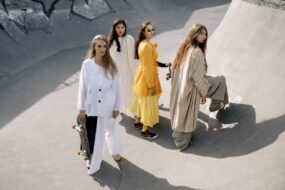
Introduction to Streetwear
Streetwear has transformed from a niche subculture into a global phenomenon. This unique blend of style, attitude, and urban culture has captured the hearts—and closets—of fashion enthusiasts everywhere. With roots in skateboarding, graffiti art, and hip-hop, streetwear tells stories through fabric and design. It’s more than just clothing; it’s an expression of identity and community.
As we dive deeper into this dynamic world, we’ll explore how streetwear evolved over the years. From its humble beginnings to becoming a staple on high-fashion runways, every step reflects cultural shifts that resonate with youth around the globe. Join us as we unravel the threads that connect streetwear to music, lifestyle trends, and its undeniable impact on today’s fashion industry.
Streetwear has transformed from a niche subculture into a global phenomenon. It’s not just about oversized hoodies or graphic tees anymore; it’s a canvas for self-expression and cultural commentary. Born on the streets, this style is deeply intertwined with music, art, and social movements.
As we walk through its journey, you’ll see how streetwear echoes the pulse of urban life. From skate parks to high-fashion runways, it tells stories of rebellion and community. Each piece carries history—reflecting the voices of those who wear them.
Join us as we explore how streetwear has evolved over time and shaped our culture in ways you might never have imagined. This isn’t just fashion; it’s a movement that bridges divides and sparks conversations around identity and belonging.
The Rise of Streetwear Brands and Designers
The rise of streetwear brands marked a significant shift in fashion culture. What started as underground style quickly captured mainstream attention. Designers began to fuse urban aesthetics with high-end influences, creating something entirely new.
Brands like Supreme and Off-White emerged as frontrunners. Their limited releases and collaborations sparked a frenzy among collectors and enthusiasts alike. This exclusivity transformed the way consumers viewed streetwear: it wasn’t just clothing; it was a lifestyle statement.
Emerging designers took cues from graffiti, skateboarding, and hip-hop culture. They incorporated bold graphics and unconventional materials that resonated with youth identity. The streets became a runway for self-expression.
As celebrities embraced these styles, visibility soared further. Streetwear transcended mere fashion—it became an art form that challenged traditional norms in the industry while redefining what luxury could be.
Streetwear’s Influence on Music and Hip-Hop Culture
Streetwear and hip-hop culture are intertwined like threads in a vibrant tapestry. As the genre evolved, so did its style, with streetwear becoming a prominent expression of identity.
Artists began using fashion as a canvas to showcase their individuality. Iconic figures like Run-D.
M.
C., Kanye West, and A$AP Rocky have made significant marks on street fashion. Their bold choices inspire countless fans.
Music videos became platforms for showcasing these styles. Brands emerged from this synergy; Supreme and Off-White gained cult status among fans eager to emulate their favorite artists.
Moreover, collaborations between rappers and designers blurred the lines further. These partnerships brought high-fashion elements into everyday wear while keeping authenticity at the forefront.
This seamless fusion continues today, reflecting not just personal taste but cultural movements that resonate across generations. Streetwear is more than clothing; it’s an extension of musical narratives that shape our worldviews.
The Mainstream Acceptance and Commercialization of Streetwear
Streetwear has undeniably crossed the boundary from niche to mainstream. Once confined to urban youth, it now graces high-end runways and luxury boutiques.
Major fashion houses have embraced this trend, collaborating with streetwear brands for limited-edition collections. These partnerships not only elevate brand prestige but also attract a younger demographic eager for exclusivity.
Retail giants have taken note too. Stores once devoted solely to high fashion now allocate space for street-inspired pieces. This shift signifies a broader acceptance of casual aesthetics in everyday wardrobes.
Social media plays a pivotal role in this transformation. Influencers showcase their unique styles, pushing the boundaries of what is deemed fashionable and desirable. The result? A rapid cycle of trends that keeps fans engaged and brands on their toes.
While commercialization brings accessibility, it also raises questions about authenticity and cultural roots within the movement’s evolution.
The Future of Streetwear and Its Impact on Fashion Industry
Streetwear is on the brink of a fascinating evolution. As sustainability gains momentum, brands are exploring eco-friendly materials and ethical production methods. This shift not only appeals to conscious consumers but also sets a new standard for the industry.
Technology will play a pivotal role in shaping its future. The rise of virtual fashion and digital wearables may redefine how we perceive clothing. Imagine owning exclusive NFT designs that exist solely online.
Collaboration with luxury brands continues to blur traditional boundaries. High-fashion houses are increasingly tapping into street culture, creating unique pieces that resonate across demographics.
As diversity becomes central to brand narratives, expect more voices from different backgrounds contributing to streetwear’s story. This inclusivity will enrich styles and broaden appeal globally, ensuring streetwear remains dynamic and relevant in the ever-changing landscape of fashion.
The future of streetwear is an intriguing tapestry woven with creativity, culture, and technology. As the lines between luxury fashion and casual wear continue to blur, we see a greater convergence of styles. Streetwear has carved out its space at fashion weeks globally, often stealing the spotlight from traditional brands.
Sustainability is becoming a focal point in this evolution. Many streetwear brands are prioritizing eco-friendly materials and ethical production practices. This shift reflects a growing consumer consciousness that values both style and sustainability.
Tech innovations play a pivotal role as well. Augmented reality (AR) allows for virtual try-ons while blockchain ensures authenticity in limited-edition releases. As technology advances, so too does the way consumers interact with fashion.
Inclusivity also shapes the landscape of streetwear’s future. The rise of gender-fluid designs encourages everyone to express themselves freely through their clothing choices. Diverse representation will only strengthen community ties within this vibrant culture.
As we look ahead, it’s clear that streetwear will continue influencing not just how we dress but also how we perceive identity and culture in our everyday lives. Its impact on the larger fashion industry remains undeniable—pushing boundaries while fostering connection among people from all walks of life.
Conclusion
Streetwear has evolved dramatically over the years, transforming from a niche movement into a global phenomenon. Its roots in urban culture and art have given it depth and authenticity that resonate with many. The rise of iconic brands and visionary designers has propelled streetwear into mainstream fashion, making it accessible to all.
The genre’s deep ties with music, particularly hip-hop, helped solidify its cultural significance. Artists became style icons, influencing countless fans around the world. This synergy between music and fashion continues to thrive today.
As streetwear finds its place in high-fashion runways and luxury boutiques, we see both acceptance and commercialization at play. It raises questions about authenticity versus mass production while simultaneously pushing boundaries within the industry.
Looking ahead, streetwear remains poised for further innovation. Sustainability is becoming more prominent as consumers demand transparency from brands. New technologies like digital fashion are on the horizon too—blurring lines between clothing and virtual expression.
What started as an underground movement now shapes trends globally. The journey of streetwear is far from over; instead, it’s just beginning a new chapter rich with possibilities that will continue to influence how we dress—and even how we think about identity itself.






















